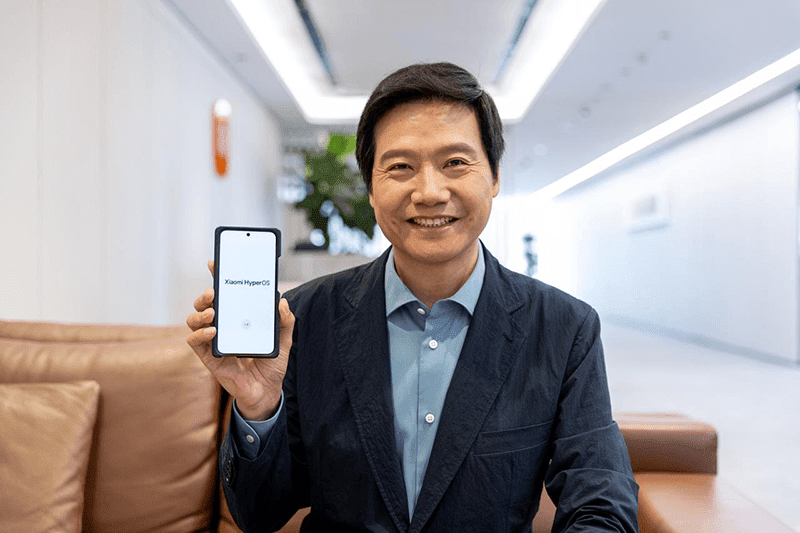Connecting Xiaomi devices in a smart ecosystem
In a recent event, Xiaomi launched its latest operating system called HyperOS. The company said this will power "its smart ecosystem of personal devices, cars, and home products."
 |
Xiaomi CEO Lei Jun flaunting HyperOS on a prototype Xiaomi device
|
The company was quoted saying: "The system marks a pivotal move forward in Xiaomi's strategic vision of delivering the 'Human x Car x Home' smart ecosystem."
Xiaomi said in a post on its website that HyperOS promises "a brand new user experience" by focusing on four major goals:
1. Low-level Refactoring
Xiaomi said HyperOS' "ultimate goal is to deliver peak device performance, ensure consistent user experience, and facilitate seamless connectivity across all Xiaomi devices."
The operating system's core is formed by Linux and Xiaomi's self-developed Xiaomi Vela system. Meanwhile, its underlying layer supports over 200 processor platforms and over 20 standard file systems, covering hundreds of device types and thousands of SKUs. For smartphones and tablets, it is Android with HyperOS.
This allows for flexible configuration, operation, and deployment in accordance with hardware requirements. The range of compatible device RAM sizes covers 64KB to 24GB. Following the principle of only configuring necessary resources based on varying hardware, coupled with file deduplication and compression of the underlying IO stack, Xiaomi HyperOS is naturally lightweight as it only occupies 8.75GB.
HyperOS also has scheduling capabilities that can accurately command hardware and tasks in diverse and complex scenarios. This is achieved through technical means such as dynamic thread priority adjustment and dynamic task cycle evaluation, resulting in optimal performance and power efficiency. This also allows for a more for a more stable frame rate and lower power consumption even when running resource-intensive games For devices with limited processing power, HyperOS supports task splitting across multiple computing units for cooperative processing, which maximizes hardware performance.
2. Cross-End Intelligent Connectivity
At the core of Hyper OS is HyperConnect which is an innovative Cross-End Intelligent Connectivity framework. This facilitates real-time networking among different devices. With an integrated device center, users can now control nearly their entire array of connected devices anywhere.
With this feature, users can easily switch camera sources during video conferencing, access car cameras from the phone, access the smartphone's rear camera while using a tablet or a laptop, and even connect the tablet to the internet via smartphone. Additionally, apps, clipboard content, and notifications can be moved effortlessly between devices as needed by the user.
3. Proactive Intelligence
HyperOS incorporates an AI subsystem supporting advanced AI technologies which enables devices to assist users proactively.
Xiaomi said HyperMind is the cognitive center of its device ecosystem, bringing pioneering cross-device connections into the era of 'proactive intelligence.' This enables devices to proactively understand user needs and act accordingly.
HyperMind also utilizes the four perceptual capabilities of devices - environment, vision, sound, and behavior, to learn user requirements and automatically adapt devices to their needs.
The Xiaomi AI Assistant also now allows direct access to large foundation model text generation capabilities via its user interface, enabling tasks like speech generation and article summarization.
To efficiently deploy large foundation models, Xiaomi HyperOS leverages its AI subsystem to integrate them into the device NPU. This support extends to Xiaomi's self-developed large foundation models on smartphones, exemplified by the imaging foundation model, which has reduced model size and memory usage by 75 percent and decreased drawing time from 100 seconds to just 5 seconds. These enhanced image generation capabilities are already enhancing features like Xiaomi AI Assistant's 'Text to Image' and 'Image Extender' in device photo albums.
4. End-to-End Security
Xiaomi's TEE serves as the foundation of its security subsystem. HyperOS also places focus on security, extending its protective umbrella not only to individual devices but also to interconnected security modules. Its interconnected security module-based TEE ensures mutual trust among devices within the network. To further safeguard the entire network, the operating system also employs end-to-end encryption through TEE for data transmission between devices.
Other changes under HyperOS
Aside from these goals, what makes HyperOS exciting are the new features that will be added to the Xiaomi device.
HyperOS will allow for more customization options for the lock screen with its new templates, fonts, and widgets. The control center will be also refined and appear more sleek than the MIUI 14 even when the icons on both look similar.
Xiaomi said the new OS will be available to consumers starting October 31 just in time for Xiaomi’s release of its latest phones, wearables, and TV sets in China.
 |
| Xiaomi 14 Pro Titanium Special Edition with HyperOS |
The Chinese manufacturer specifically said HyperOS will be pre-installed in the new
Xiaomi 14 Series, as well as other devices launched in the company’s domestic markets, such as the Xiaomi Watch S3, Xiaomi TV S Pro 85" miniLED, and more.
What do you think about this?







Post a Comment